






|
2013 |
 |
 |
 |
 |
 |
 |
 |
|
I will be leaving for Munich and then Warsaw in a few hours; while in Poland I hope to find some time to convert my recently-made E-M1 cheat-sheet into a full-fledged article on setting the camera up so that it fits your needs and habits. Back on January 7. In the meantime: Merry Christmas, everyone! | |
|
E-M1 Image Stabilization Tested: trying to find some excuse for not packing for the upcoming Polish trip, I did two series of my standard IS testing on this camera, at focal lengths of 50 and 300 mm. No surprises: the shutter speed gain at the 50% success rate is 1.3 or 1.85 EV, respectively, which is just fine and basically unchanged since the E-510 in 2007. Yesterday's note about handheld results at 1/2 s was a bit premature. It is easy to miss a slight blur in IR, because the picture is a bit blurry by itself: focusing and wind. After a re-check, two frames out of six turned out to be really acceptable (although the others were not really bad). Now I need to find something to do instead of my laundry... |

E-M5, 75-300/4.8-6.7 MZD at 281 mm |
|
| |
|
Another small article on E-M1, this time about its usability in infrared photography. While this is not the best time for IR shooting (no green foliage, no Woods effect), I was able to determine that this camera needs IR exposures about 1000× longer (10 EV) than in visible light; this is similar to the E-510 and about 1 EV better than in the E-30. Interestingly, it looks that the new IS system provides satisfactory handheld results at exposures of 1/2 s or so (at 40 mm), although this depends on your shooting technique. Combined with image quality at ISO 6400 and higher, this helps a lot. |
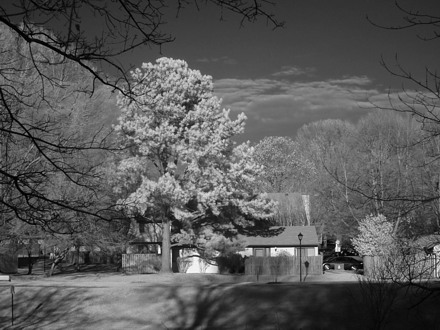
E-M1, Hoya R72 filter, 12-50/3.5-6.3 ZD at 40 mm, |
|
I just posted a new piece: E-M1 Picture Modes, with samples and a discussion of that feature. In particular, I would like to figure out what the i-Enhance mode does — in addition of having a stupid name and brightening the whole picture a bit. Also, I added a few new items to the E-M1 Full Monty article (the list of changes is provided, so you don't have to go through the whole thing again). This will be my last weekend before going to Poland for the Christmas break and to do some work in my company's office there. (While I've been living in the U.S. for more than thirty years, I still do that every year.) I hope to squeeze one more article into that time, but there are too many subjects lined up, a tough choice. | |
|
New Gallery page: Dominica in the Caribbeans (sometimes confused with Dominicana). This is the biggest one so far: 70 or so images, shot with the E-30 and (mostly) the 12-60 mm ZD. Dominica is a place for photographers. Instead of white sand against water and sky (boring!), it offers a good variety of subjects, something new around every corner.
|
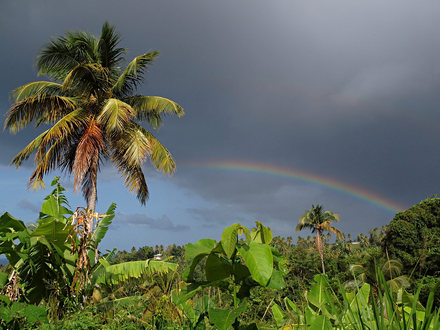
|
|
It is already Monday, and I am adding another article: E-M1 Macro and Close-Ups, applicable also to the E-M5, of course. For that, I've put two standard OM-D zooms through some tests, along with the legacy 50 mm Macro from the FT lens line. It would be interesting to try the μFT 60 mm Macro, but I don't have it. Thank you all who wrote me in the last two days since I published my new email address here, for the words of care, encouragement, and appreciation. Don't expect much new here during the upcoming week, but there should be some added over the weekend again. | |
|
Another new OM-D article, this time it is While I was expecting the high-ISO performance of this camera to be good, I haven't hoped for something that good. The example shown at the right (taken from that article) has been shot at ISO 12,800!
E-M1 with MZD 75 mm F/1.8 Click on the image to see the screen (960×1280) version... ...and here is the original full frame |

|
|
After posting the article last night, I shot a few more gourd images using the MZD 75 mm F/1.8 lens, with in-camera Noise Filter function set to Off. Lo and behold, looks like this may become my E-M1 setting of choice now (if not by far); thus I had to expand the article (and to replace the picture shown above). | |
|
Picture of the Week: The Chesapeake Bay Bridge in Maryland, August this year, as seen from Lola's Bar and Grill.
Olympus E-M5 with MZD 75-300 mm F/4.8-6.7 at 300 mm;
If you would like to have an idea about imaging capabilities of this camera/lens combination, have a look at the full-scale, unaltered original frame. |
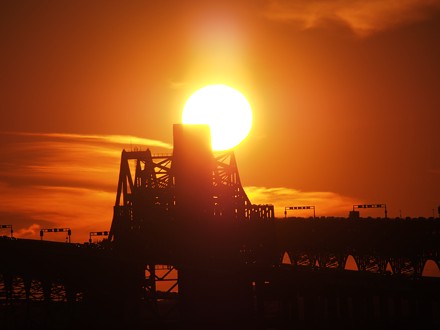
|
|
The E-M1 First Look, originally intended as a quickie, grew into a something larger, and here it is: The Santa came early this year and brought me the MZD 12-40 mm F/2.8 Pro. I must have been good this year, indeed! This constant-aperture, premium standard zoom for OM-D cameras is smaller than I thought it would be (see the 75 mm F/1.8 below), attractively made and finished, and — listen! — it t comes with a hood (no friction to put it on, position-locking buttons, premium quality). And just a few days ago I was complaining about the Olympus no-hood policy? Did they fire the guy who invented it?
If you would like to reach me by email, here is the address I will be using for photography-related correspondence: I just finished the analysis, write-up and formatting of the EM-1 Samples, Part 2 (shot with the 12-50, 40-150 and 75-300 mm lenses at varying apertures), and to say I am impressed is not enough. Last-minute update: the 75mm F/1.8 ZD arrived. The first impression (build and finish) is good, the lens is also smaller than I expected, complementing the E-M1 body perfectly (in the cosmetic sense, that is). A sample session will, unfortunately, have to wait till the weekend. A fly in the ointment: it comes without a hood, and for almost all lenses that is the most effective accessory money can buy. This seems to be a new policy invented by some business genius at Olympus: most (probably all?) new μFT lenses by them list hoods as optional accessories only (sometimes not really available). Selling (in this particular case) a lens for $900, only to charge you $75 for a piece of plastic which costs $2 to make — how smart. (Other dedicated hoods for Olympus μFT lenses sell at $35 to $75.) As a sign of my personal protest I made a resolution not to buy any Olympus hoods until they are back in the product box. Consider joining me in that. | |
|
The E-M1 First Look is progressing, if with some hiccups and delays — too many small things to check and verify. In the meantime, I'm posting today My Road to the E-M1, an introduction to that camera for someone, like myself, migrating from the Olympus E-System to the OM-D line. | |
|
Also, by tomorrow I should have the MZD 75mm/1.8, one of the nicer μFT lenses available; this looks like a busy week ahead. (As much as I like the silver/chrome finish, I'm getting this lens in black: safer when there are some reflective or semi-reflective surfaces in your picture.) With this, and with the 12-40mm/2.8 expected from B&H within (hopefully) days, I will probably need only the 7-14mm by Panasonic to round up my μFT lens system. It remains to be seen how often will I use my two favorite FT lenses: the 12-60 and 50mm Macro. |
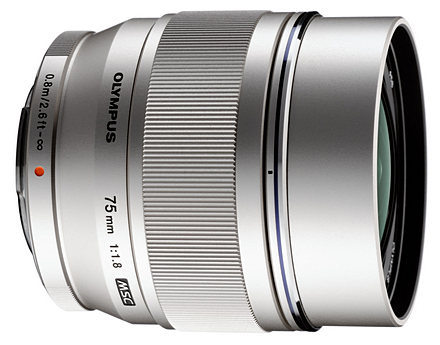
(Image © by Olympus) |
|
Speaking about lenses: I'm very tempted to try (at least) one of the brightest lenses commercially available for any camera: one of the Nokton line made by Cosina under the premium Voigtländer brand: the 17.5, 25, and 42.5 mm share the same aperture of F/0.95 (at current prices of $1000-$1150), made in the μFT mount. The caveat: manual focus only, and autoexposure in step-down aperture priority: no electronic connections. Still, stepped-down metering does not bother me, given the electronic finder (it would be a deal-breaker for an SLR), and the E-M1 has a nice manual focus-assist function (supposedly, I have to try it yet). Expensive? Compare that to a (full-frame) Leica 50mm/0.95 Noctilux at $11,000, the only offering matching the Noktons. | |
|
Another two days with the E-M1, and I am really enjoying the camera a lot! It has so many things, big and small, done just right. For me, this may be the most significant Olympus development since the
First of all, I did some more informal AF tests of a number of the Four Thirds lenses on the E-M1 body (along with the E-M5 and E-620 for comparison). Having repeated the series outdoors and indoors, I can clearly say that all lenses I've tried are autofocusing on the M-E5 not worse (but not better) than on the E-620. These included the kit zooms: original ones from 2003 as well as the compacts introduced in 2006; but, more importantly, also some of my favorite Zuiko glass: the Secondly, I did two runs of controlled-environment samples at the ISO ranging from 100 to 25600. While I will present the results in a separate article, I am not afraid to say that the E-M1 image noise at ISO 25600 is comparable (perhaps a tad better) than that of the E-30 or E-620 at ISO 3200. Not too shabby! And lastly, I stumbled on an option I've missed before (it was not there on the E-M5, so I wasn't even looking): reassignment of mode dial positions. Yes, the slots you do not need can be assigned to user-defined parameter presets, My Modes. (I've been complaining about this since the E-500 in 2005; it took just 8 years for Olympus to see the light!) | |
|
As much as I like the E-M1, here is a worthy μFT competitor to it: the Lumix GX7 by Panasonic, announced recently and available soon.
Briefly: a compact and sturdy magnesium alloy body, eye-level EVF (tiltable!), built-in flash and articulated monitor; 16-MPx sensor and — listen! — body-based image stabilization. The latter means the camera will provide IS also with Olympus μFT lenses, still retaining the in-lens Mega OIS in-lens capability if available — like in the latest Olympus models (including OM-D ones). I'm glad both companies finally sorted it out among themselves. |
.s.jpg) (Promotional image by Panasonic) |
|
This is one of these cameras which keep you (or, at least, me) salivating. Also, the GX7 is smaller than the E-M1 (123×71 as compared to 130×94 mm), about 20% lighter (402 vs 497 g), and that in spite of the flash and tilted finder. DP Review (for the last few years owned by Amazon, remember?) has posted a full review of that camera last week, have a look. I decided in favor of the E-M1 mostly because of the full FT lens compatibility and my general familiarity with how Olympus does things, but, to be honest, it was a close run. Now what I need is a good pretext to get a GX7 anyway... | |
|
The new E-M1, preordered since mid-September, finally was delivered last Thursday, more than three weeks after the official U.S. availability date (October 20). I got it from B&H, but last time I looked Amazon was also out of stock; these babies are selling like hot cakes. | |
|
The camera looks and feels better than the E-M5 (of which I don't have real complaints anyway), and after a few hundred frames shot over the weekend, I am quite pleased with the results (although I wouldn't be able to tell them apart from those by E-M5). Obviously, I started working on a First Look which should take about a week. At this moment, my major problem with the E-M1 may be, indeed, the price: $1400 for body alone is out of reach of quite a few enthusiasts, and a bit steep compared to some of the competition. Add to it another $500 for the 12-50 mm MZD lens, or $1000 for the about-to-arrive 12-40 F/2.8, and you end up spending two grand or more for a camera with one lens. Aargh! Still, it looks like a justified expense... |
.t.jpg) (Promotional picture by Olympus) |
|
One clear improvement is in autofocus. While the contrast-detection (sensor-plane) AF, used best with Micro Four Thirds (μFT) lenses, has been slightly improved (it is now a class in itself), the real breakthrough is the new sensor-plane, phase-detection AF. This means that (non-Micro) FT lenses will autofocus properly with the new camera. I was able to verify that on two lenses so far: the 12-60 mm F/2.8-4.0 and 50 mm F/2.0 macro. Hallelujah! Both seem to focus as responsively on the E-M1 as they do on the E-620 as far as I can tell, even in the relatively dim, artificial light of my living room by night. In a bold move, the sensor sacrifices 12.5% of formerly "green" photosites, removing from them the green filter and devoting them exclusively to phase-detected AF. This means that one million (!) photosites have been excluded from image creation (the data for these points is now interpolated in all three components, not just blue and red as before). | |
|
While I am still learning to live with the new camera, here are the E-M1 Image Samples, Part 1 shot at default settings at low ISO and using (mostly) my regular subject: the lake in my neighborhood. More to come. My first impressions: typical Olympus colors (good!), most sunny frames need some negative compensation, default sharpening is a bit too high, the 12-50 mm F/3.5-6.3 lens offers first-class resolution, not a sign of chromatic aberration in corner high-contrast transitions. Looks real good so far. |
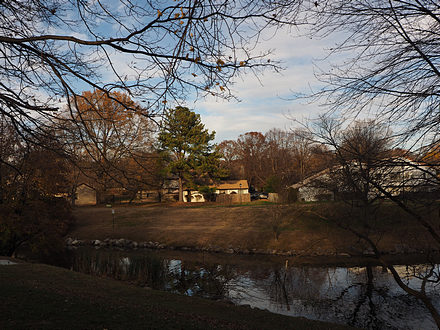
Olympus E-M1, MZD 12-50 mm F/3.5-6.3 at 18 mm; |
|
My E-5 First Look from 2010 is no longer by invitation only; it has been cleaned up a bit and made accessible from the E-System page. | |
|
Surprise! I'm back after almost four years of absence on the Web. While the Olympus SLR line is dead, I am not, so expect — again — to see some opinionated writing on photography in general, and Olympus cameras in particular, now focusing mostly on the Micro Four Thirds line of OM-D cameras. Check this page on Mondays, as most of this writing happens on weekends. |
|
For starters, a new Gallery page: The Tetons, shot with the E-M5 last fall. The camera turned out to be a capable performer; I found myself using it 90% of the time (with the E-30 used for the remaining 10%). I am also cleaning up two articles originally written during the hiatus, but accessible only by invitation (i.e., without being linked to); at least one should be presentable by Monday. |
 |
 |
 |
 |
 |
 |
 |
| Home: wrotniak.net | Search this site | Change font size |
| Posted 2006/01/30; last updated 2013/12/13 | Copyright © 2006-2013 by J. Andrzej Wrotniak |